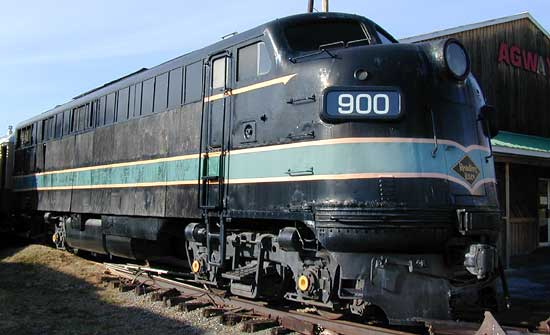RDG Co. EMD FP7, Class DP-1, #900

#900 at Leesport yard, January 2002. (photo courtesy Mike Shirk)
Background & History
Reading FP7A #900 was part of the original order of six units placed by the Reading Company in March of 1950. Initially the order was for three FP7A’s and three F7B’s to replace the steam power on the Crusader, Wall Street and other trains, but this was changed to all FP7A’s, due to, among other reasons, turntable size constraints at Green Street passenger enginehouse and greater steam generator capacity.
The units were completed and shipped in pairs, working their way east on the B&O. They powered their first Reading passenger train, the Wall Street, on June 6, 1950. The Reading acquired two more units in 1952, and all eight continued in use until the mid 1960s. Due to declining ridership and smaller trains, the pairs were often broken up and used as sole power on a run, except on the Crusader and Wall Street, which still rated two units.
The acquisition of RDC’s by the Reading and their increased use on passenger trains allowed the Reading to start to dispose of its FP7A’s. Two units, Nos. 904 and 905, were retired in 1965 and traded in to ALCO for C630’s. In 1966, #906 went to EMD as a trade-in for SD45’s, and two years later Nos. 901 and 907 were sold to EMD, leaving #900, #902 and #903 still on the roster.
The remaining units were used in push-pull service on the Reading to Philadelphia run, with one unit kept as a backup. This service continued after SEPTA took ownership of the train in 1974, and after Conrail assumed operation of the train in 1976. In 1977, SEPTA had “SEPTA OWNER” stenciled on the side of the units, and they were renumbered on paper into the Conrail numbering system.
In February of 1978 SEPTA decided to apply a new paint scheme to the train, and the infamous red, white and blue “Circus Train” was born. The plan was to rotate the equipment out individually so as not to interrupt service. But later that month, the train derailed in Norristown, and it was decided that the entire train would be pulled and replaced by RDC’s while it was repaired and repainted. The complete “Circus Train” debuted in June of 1978. During its service under SEPTA, the train was also often used on the Bethlehem Branch in between its runs to and from Reading.
In 1981, with the anticipated opening of the Commuter Rail Tunnel in Philadelphia, SEPTA decided to cease all non-electrified rail service, and the train was retired and stored at SEPTA’s Wayne electric shop, except for #903 which was stored in Reading. The future of the equipment was unknown, but fortunately fate would be much kinder to the remaining units than it had been to their sisters.
#902 was sold to the National Railway Historical Society (NRHS) Lancaster Chapter and along with sister #903 (purchased by the (NRHS) Philadelphia Chapter in September of 1983) underwent a lengthy restoration process that began in 1986. Both completed units were finally dedicated in 1995 and have been used in excursion service since. They currently are stored in Pocopson when not in use.
The (NHRS) Philadelphia Chapter also purchased #900 from SEPTA in 1983, with intentions of donating it to the Railroad Museum of Pennsylvania in Strasburg, where it was sent for storage in September of 1983. But negotiations fell through, and instead the unit was leased and finally purchased by the RCT&HS. It has since been partially cosmetically restored and is planned for a complete restoration.*
Archival Photos
• #900 at Phoenixville, PA, 1975. (photo courtesy R. Louderback)
| EMD FP7A Specifications (as-built): | |||
|---|---|---|---|
| Builder: | Electro-Motive Division, General Motors, LaGrange, IL |
Engine model: | 16V-251E |
| Date built: | 1950 | Type: | 2-stroke diesel |
| Builder’s #: | 11387 | Aspiration: | Roots blower |
| Horsepower: | 1500 | Cylinders: | 16 (Vee) |
| Top speed: | 89 m.p.h. | Bore x Stroke: | 8.5" x 10" |
| Weight: | 255,100 lbs. | Displacement: | 9,072 c.i. |
| Tractive effort: | 63,775 lbs. | Idle Speed: | 275 r.p.m. |
| Length: | 54' 11" | Max. speed: | 800 r.p.m. |
| Fuel: | 1,200 gallons | Transmission: | DC generator, DC traction motors |
| Lube oil: | 200 gallons | Brake system: | 24-RL |
| Water: | 230 gallons | Braking: | Air and dynamic |
| Boiler water: | 1750 gallons | Special: | Steam boiler |
| Notes: | |
|---|---|
| *(info courtesy Philadelphia Chapter of the National Railway Historical Society) | (last updated: 4/03) |